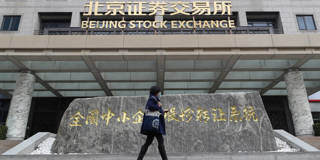In recent years, China’s “great transformation” into the world’s largest economy (based on purchasing power parity) has become enmeshed in a deepening confrontation with the US and the wider West. This dynamic reflects an outdated Cold War mindset on both sides that is utterly unsuited to today’s global challenges.
HONG KONG – In his 1944 classic The Road to Serfdom, the Austrian economist and philosopher Friedrich August von Hayek warned that central planning and public ownership would inevitably lead to hardship, oppression, and even tyranny, while free markets would naturally maximize general welfare. The same year, in The Great Transformation, the American-Hungarian economic historian Karl Polanyi offered a very different picture, arguing that market forces and society are locked in a kind of struggle: capitalists exploit society through free markets, and society pushes back through regulation and politics.
Nearly 80 years later, debates over Polanyi and Hayek’s opposing views still echo through the halls of power in Beijing and Washington. While the West essentially adopted Hayek’s liberal order of free markets and democracy, China broadly followed Polanyi’s “great transformation,” becoming the world’s largest economy (based on purchasing power parity) and nearly eradicating absolute poverty.
Of course, China’s great transformation would have been impossible without economic opening and market-oriented reforms. For decades, the United States played a critical role in enabling and sustaining this process, not least by creating the conditions for globalization to flourish. American technology, military might, and diplomacy bolstered global security – few can deny the poverty-reducing potential of a peace dividend – while a stable US dollar facilitated international exchange.

HONG KONG – In his 1944 classic The Road to Serfdom, the Austrian economist and philosopher Friedrich August von Hayek warned that central planning and public ownership would inevitably lead to hardship, oppression, and even tyranny, while free markets would naturally maximize general welfare. The same year, in The Great Transformation, the American-Hungarian economic historian Karl Polanyi offered a very different picture, arguing that market forces and society are locked in a kind of struggle: capitalists exploit society through free markets, and society pushes back through regulation and politics.
Nearly 80 years later, debates over Polanyi and Hayek’s opposing views still echo through the halls of power in Beijing and Washington. While the West essentially adopted Hayek’s liberal order of free markets and democracy, China broadly followed Polanyi’s “great transformation,” becoming the world’s largest economy (based on purchasing power parity) and nearly eradicating absolute poverty.
Of course, China’s great transformation would have been impossible without economic opening and market-oriented reforms. For decades, the United States played a critical role in enabling and sustaining this process, not least by creating the conditions for globalization to flourish. American technology, military might, and diplomacy bolstered global security – few can deny the poverty-reducing potential of a peace dividend – while a stable US dollar facilitated international exchange.